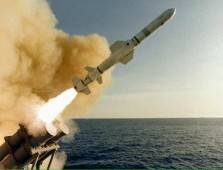Its not resonable, first becouse booster is exactly for that - gaining speed, and second becouse you are insisting what Harpoon will be launched behind radar horizont.We are talking about the 1980's, so it is Falklands type environment we're discussing.
It would be reasonable to think that the weight difference is made up by the booster giving the same range for the two missiles. The weight difference is in the ballpark. Further check out the physical appearance of the two missiles and it can be seen the difference is the booster.


So it will be reasonable to think they will have the same range when launched under the same circumstances and that if launched at altitude, the range will increase.
Thats right, not relevant.Actually that upgrade did go ahead.
"Maximum range for surface launches is around 140 km (75 nm)."
http://www.designation-systems.net/dusrm/m-84.html
Some of the current versions have a 220 km range. But not really relevant for what we're discussing.
Nope, its was slightly increased. But 1065km for it sound more like half ferry range. The range of 290m was given for a typical hi-lo-lo-hi profile. The same source mentions typical max interdiction range of 150nm.I understand the combat radius of the F/A-18A to be similar of that of the C, which is 575 nm or 1,065 km.
An example http://en.wikipedia.org/wiki/F-18. These number are generally accepted and quoted in most sources.
Hmm, you should already set you mind - do you planning launching harpoons from 10km height so the can fly farther or from 200m height so soviet cruisers will not see them?They don't need speed. They just need to have the appropriate avionics and then carry the missile at low altitudes. They do this very well. If they fly below 200 m the Soviet surface group will never see them.
Maximum cruising speed is 426 mph or 682 km/h. This is more than adequate.
Yes, you right about that trick. But soviet also know that trick and will try to avoid getting close to USA CBG outside of bad weather or maritime air support.I used 2 Harpoons in my example. That's good enough.
The trick is that it will never come to that, as the cruiser is dead before getting into firing range.
Hmm, doubt it pretty much. Sub is very, very hard to find, whereas CBG is easely found with sattelites. Soviet cruisers will simply avoid USA CBG while trying to intercept USA suply lines. In fact, i'm sure what its CBG will be sitting ducks against soviet SSN's. You cant really compare the difficulties to find and destroy a sub cruising 500m underwater and a big battle group of surface ships.The role of the USN carriers would clearly be to engage Soviet surface action groups. And to defend itself from enemy subs/air. The ASW groups will do the subhunting. Smaller soviet squadrons or single ships will be hunted down using air power from smaller carriers and land based air. They are sitting ducks.
NATO surface groups couldnt do anything on they own without a carrier, they are literaly slaved to it. Even in hypothetical situation where soviet SSN is alone against USA ASW vessel all my bets would be on SSN as it have much longer ranged missiles.The NATO surface groups won't engage and stay clear of powerful Soviet surface groups, they will focus on sub hunting. The Soviet surface groups are to be interdicted by carrier aviation before getting anywhere near the supply lines; who also can displace according to threat.
Ya, and soviet cruiser commander will also "have to look in the weather forecast and avoid getting ito such a situation". So, it will be down to commander skill and survivalnce assets.Then the CVN commander will have to look in the weather forecast and avoid getting ito such a situation. The carrier aviation makes it possible for the CVN to choose when to fight and on what terms.
Ya, they will hunt each other as you see.Better stay in port then, all the while NATO hunts down the SSN and SSBN.
